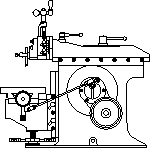

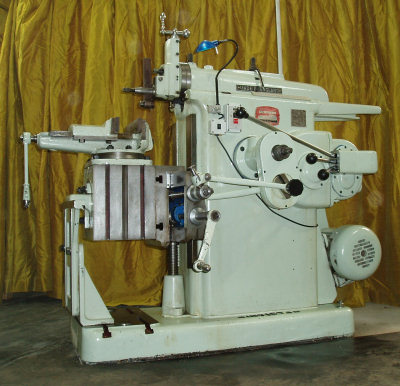
14" Invicta Shaper
Photo by Peter Darveniza
14" Elliot Invicta Photo by Peter Darveniza "Ever since I used a shaper as a teenager at Technical School in the 1960s to make a small bench vice, I wanted one, I was "entranced" by the slow purposeful mechanical motion of the machine.
In the meantime I went on to University and qualified as a Mining Engineer and subsequently worked in many parts of Australia and overseas, the constant moves were not conducive to having a workshop. Finally in 1998 I settled down with my young family in Ballarat Victoria. Now I could set up a workshop! I acquired a lathe, drill and mill drill and began the hunt for a shaper.
After constant searching I found one advertised in the local Saturday paper, "Shaper for sale with slotting attachment, $400" with a phone number. I rang and confirmed I was interested noting that it was located at Enfield, about 40 km (25 miles) away.
Enfield is a country area largely covered by bush in rolling hills. The area is pock marked with mine shafts and diggings from the 1850s. Following the directions I had carefully written down, I drove down a series of winding muddy dirt tracks finally arriving at a clearing in the middle of the forest where a big shed was located beside a house, the only civilisation in the middle of a vast expanse of wild bush.

10" Unknown Shaper
Photo by Peter Darveniza
The shed housed a wonderful array of all sorts of metalworking machines. The owner said he was an inventor and was not keen for me to enter the workshop in case I saw a new invention that he was working on. Something on a bench was mysteriously covered by a large cloth. Grid power did not extend to this area; the machinery was powered from a large 3-phase generator maintained and operated by the owner.
The shaper was outside in the open, covered by an old canvas tarp. My initial reaction was that it looked pretty sad, however a shaper is a shaper and it was the first one I had managed to find. It was roughly painted an ugly dark green. The owner had used it up until 2 years ago for cutting keyways but it was now no longer required. Closer examination revealed a very old machine that appeared to be in reasonable condition despite a rust seized ram. Oil applied to the ram and some gentle rocking of the flat belt drive pulley eventually got it going, I became more interested.
It was an old shaper with no identifiable maker; it looked to be about a 10" stroke. I thought it was probably a "war finish" shaper, made during one of the world wars; rough finish, no embellishments but serviceable and accurate. It had a 3 step flat belt drive pulley and the stroke was set by opening a door in the side and setting an adjusting screw which slid the rocking arm die block across the bull wheel thus varying the stroke. The internals were well greased and in good condition. It did not come with any accessories such as handles or a vice and the "T" slots in the table had been broken out in 2 spots. It had no motor or gear box. The owner knew nothing about its previous history or where it originated; his father had bought it years ago. I agreed to buy it and paid the $400 [$333 US], I had a shaper!
I returned the same day with a trailer and a friend to help me move the shaper. Moving did not prove to be a great trial despite its weight. We pulled the shaper up into the trailer on thick hardwood planks using a chain block. It was then tied down with ropes and nylon webbing. This held well on the rough undulating road. Unloading into the workshop was the reverse of loading and went without a hitch. Over the next few weekends I built a drive mechanism frame and bought an electric motor and some flat belt. I made a tool holder from a bicycle crank to replace the keyway cutter; this allowed the cutting tool to be held at varying angles.
When I finally hit the start button the shaper kicked into life and operated as it should, all functions worked. I initially used my milling vice to hold items. An adjustable spanner was used to adjust table height. This shaper served me well for over one year and was successfully used on many jobs.
One Saturday while reading the "tenders" [Sealed bid auctions] section of the local paper I noticed that the former Daylesford Technical School had a number of surplus metalworking machines up for tender, including a shaper. I quickly rang a friend; he was interested in a lathe listed on the tender list. So we arranged to go over the next week and inspect the equipment. Daylesford is 45km (28 miles) from Ballarat.
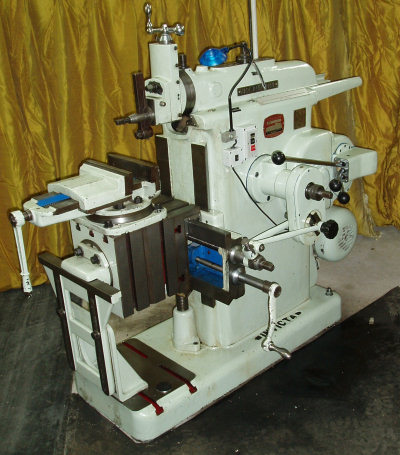
14" Invicta
Photo by Peter Darveniza
The shaper was immaculate! It was a 14" Invicta, made in England. It came with all the accessories, including a 10" vice, handles and spanners. It was three phase. I turned it on and it ran smoothly, a closer examination revealed that it had been well cared for. I had to have this shaper!
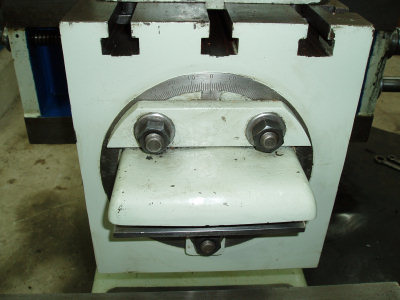
Table Support
Photo by Peter Darveniza
It looked to me like the one I had used in Shepparton 30 years ago to make my small vice. This was a luxury machine compared to the shaper I currently had which I had to switch on/off at the wall. Cutting speed adjustment was achieved by changing flat belts and the stroke was adjusted through a side door in the shaper; all very archaic and primitive. This shaper had a clutch. The stroke adjustment was by crank from outside the machine. It has 6 speeds readily selectable using 2 levers varying the strokes per minute between 12 and 110. My friend agreed with my assessment, we examined the lathe he was interested in; it was also worth tendering for.
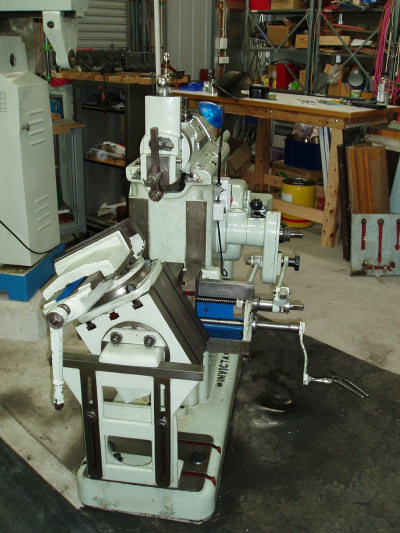
Table Tilted & Supported
Photo by Peter Darveniza
I mulled over the tender price, I thought I could probably get it for $500, there was no guide, and as it was a tender I only had one chance to get it right, I had no idea who else might be interested, only that it had been widely advertised in the local paper. I thought that its relative "remoteness" (Daylesford pop. 10,000 compared to Ballarat 90,000) would work in my favour. People aren't willing to travel to buy this sort of thing, are they? I worried over the price; how good is this shaper, how badly do I want it I thought? Answer; It is a "Rolls Royce" shaper, in almost as new condition; I really, really want it.
I reconsidered my price and decided that $500 wasn't enough to definitely secure it, so when tender submission time came I tendered $820 [$684 US] for the shaper and $300 for a surface grinder with a magnetic chuck. My friend tendered $600 for the "Hercus" (South Bend copy) lathe.
A week later I was elated to receive a phone call from the School confirming that my tender for the shaper and surface grinder had been accepted as had my friends lathe tender. You Beauty!
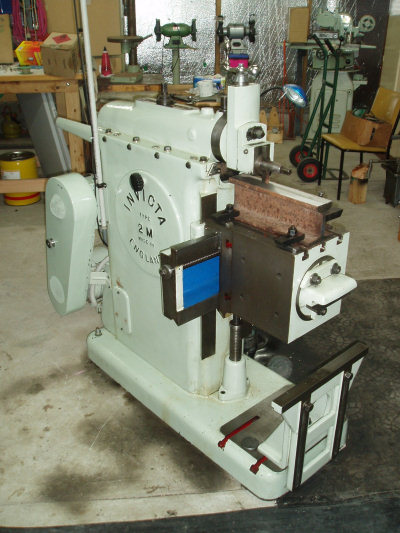
Left
Photo by Peter Darveniza
So the next challenge was how to move an 850kg (1,870 lbs) shaper out of a workshop, and down a flight of stairs into a trailer and ultimately into my workshop. This was a considerably bigger and heavier shaper than the one I already had. I did a preliminary trip over to assess the shaper and brought back detachable ancillary items such as the vice, table support and pieces of the surface grinder. A discussion at the school with the successful tenderer for a horizontal mill revealed that he had tendered $600 for the shaper, just as well I'd lifted my bid from $500 or I'd have missed out!
The move generally went well except for an incident when the shaper overbalanced and tipped on its side, fortunately no damage was sustained. I asked a teacher at the school if there was any documentation for the shaper, after a short rummage in a filing cabinet he produced the original operating manual. Fantastic!
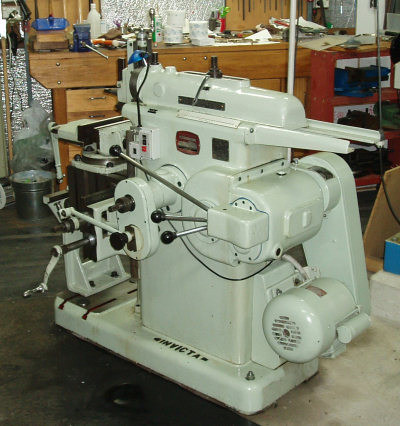
Rear
Photo by Peter Darveniza
Once home I decided on a long period of cleanup and refurbishment including conversion from three phase to single phase. I started to pull the whole machine down, cleaning each part in kerosene, followed by degreasing, priming and painting, followed by reassembly. This took about 6 months and confirmed the excellent condition of the machine. I intended to spray paint the shaper with car enamel but as not all items were ready to paint at the same time this was very wasteful as regards paint. I finished up hand painting the shaper which resulted in an acceptable finish. I added hardener to the paint to ensure it was hard wearing and changed the original colour of the shaper from a dull grey to a lighter green/grey to match my other workshop machinery. As I painted it in winter I covered it with a "space blanket" and heated it with an electric-fan heater which helped the paint dry.
I went back to the "For Sale" ads in the local newspaper and found an ad for a single phase 750Kw (1 HP) motor for $90, I rang and quickly went over to inspect it. I was disappointed to find it on the floor of a chook [Chicken] shed covered in chook manure. It looked awful. "It's a goer" the owner brightly assured me and plugged it in to prove his point, it ran. I paid him the $90 took it home, cleaned it up and painted it. It is still running well after 5 years. This motor replaced the original three-phase 3HP motor and is more than adequate for the job, I have never lacked machining power and I take heavy cuts from time to time. Both motors ran at essentially the same speed, 1420 & 1459 rpm, this is a less than a 3% increase in speed which is negligible.
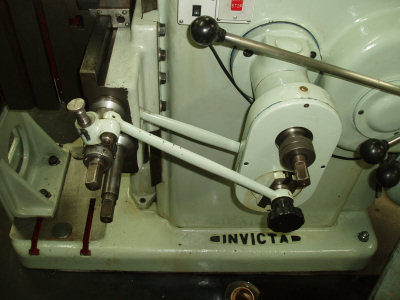
Controls
Photo by Peter Darveniza
Finally the big day came to test my new acquisition. I put a piece of mild steel in the vice, a newly sharpened HSS tool in the tool holder and "let her rip". Disappointment! All functions worked well but the finish was like that of a rat gnawing on a piece of cheese, the tool appeared to be jumping. I found that the tool feed nut was worn and consequently the tool slide was sliding up and down according to the cutting load. So I bought a block of brass at a local foundry and set about turning a ½" internal acme thread. Once this was fitted, the shaper performed to perfection and has continued to do so since that time.
It is the pride and joy of my workshop. I have a vertical and horizontal mill but always use the shaper in preference as it generally gives a better finish. I am very proud of my shaper.
I sold the other shaper to the friend who bought the lathe at Daylesford. As he has 3 shapers I jokingly refer to his phantom "business" as "Shapers R Us - shape up or ship out". He accumulates old metalworking machinery and usually swaps to acquire other desirable machines."
Thanks Peter for that great acquisition and rebuild story.
Keep sending me email with questions and interesting shaper stories.
My email address is KayPatFisher@gmail.com.